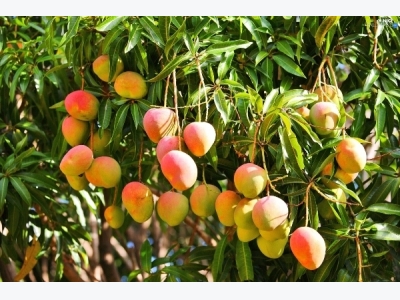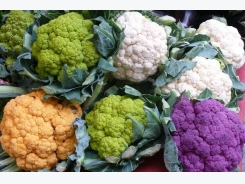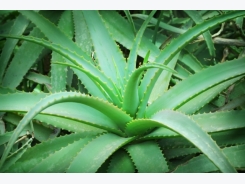Mango Farming Information Guide

Introduction of Mango Farming:- The mango is a juicy stone fruit and belong to the family of “Anacardiaceae” and genus of “Mangifera”. Mangoes have been grown in South Asia for thousands of years & reached East Asia between the 5th and 4th centuries. Mango is one of the top fruit crops of India and other Asian countries. Mango fruit is called the king of fruits. Mangos are delicious, excellent flavour and attractive fragrance, these fruits are good source of vitamin ‘A’ and Vitamin ‘C’. Mango trees are hardy in nature, can be grown in a wide-range of soils and require comparatively low maintenance. These fruits can be utilized at all stages of its development. Raw mangoes are used for making chutney (pickle) and juices. The ripe mangos can be used in preparing desert, squashes, syrups, nectars, jellies and jams. This fruit kernel also contains 8 to 10 % good quality fat which can be used for soap and also as a substitute for cocoa butter in confectioneries. Commercial cultivation of mango crop is very much successful in southEast Asia. Mango trees can be grown in pots, back yards, greenhouses and poly houses as well.

Green Mango
Health Benefits and Nutrition Facts of Mango:- The following are the health benefits of mango fruits.

Health Benefits of Mango
- Mango fruit may prevent cancer.
- Mango fruit is good for skin.
- Mangos help in boosting immune system
- Mango fruit is good for eye health.
- Mangos are good for heart health.
- Mangos improve digestion.
- Mango fruit may lower cholesterol level.
- Mango fruit may alkalizes the whole body.
Top 10 Producers of Mango in the World:- The following countries are the top producers of mango fruits. Major Mango Production States in India:- Uttar Pradesh, Andhra Pradesh, Telangana, Karnataka, Bihar, Gujarat and Tamil Nadu.
Local Names of Mango in Asia:- Svoaix’ar (Taiwanese), Anbe (Persian), Mangga (Malay), Mango (Turkish), манго (Russian),マンゴー (Japanese), Svaay (Cambodian), xoài (Vietnamese), Mamuang (Thai), 芒果 (Mandarin), Paho (Filipino), 芒果, mángguǒ (Chinese), مانجو) Arabic), Aanp(Nepali), 망고 (Korean), Amro (Mongolian), Ambā,අඹ (Sinhalese, Sri Lanka), Aam (Hindi, India).
Local Names of Mango in India:- Aam (paka), (Bengali, Hindi, Urdu), Keri (Gujarati), Mavina hannu (Kannada), Amb (Kashmiri, Panjabi), Mam pazham (Malayalam, Tamil), Amba (piklela), (Marathi), Amba (pachila) (Oriya), Heinou (Manipuri), Aambo (Konkani),Mamidi pandu (Telugu).
Varieties of Mango:- There are many hybrid varieties of mango cultivated across south east Asia region. There are more than 1000 improved varieties grown in India itself. Some of the most cultivated cultivars in India are Alphonso, Bangalora, Banganpalli, Ratna, Dashehari, Fazli, Arka Anmol, Fernandin, Himsagar, Kesar, Kishen Bhog, Bombai, Bombay Green, Langra, Mankhurd, Arka Puneet, Mulgoa,Arka Aruna, Neelam, Samarbehist, Chausa, Suvarnarekha, Vanaraj, Zardalu,Mallika, Amrapali, Manjeera and Himayath.

Tall mango Variety
Climate Requirement For Mango Farming:- Mangos can be cultivated in both tropical and sub-tropical regions from sea level to 1500 meter altitude, provided there is no high humidity, rain or frost during the flowering stage. Having good rainfall and dry summer is best suitable conditions to grow mangos. Avoid areas with high winds and cyclones which may cause flowers and fruits shedding and breaking of branches.
Soil Requirement for Mango Farming:- Mango fruits can be cultivated on wide variety of soils from alluvial to laterite. The soil should be well-drained and deep (minimum of 6′). Mango trees prefer slightly acidic soils with pH 5.5 to 8.0.
Propagation in Mango Farming:- Vegetative method ( true to type plants from recognized nurseries) of propagation is most recommended one. Mango can be propagated by seeds, Inarching, veneer grafting, side grafting and epicotyl grafting.

Grafted Mango Seedlings

Mango Seeds
Land Preparation, Planting and Spacing in Mango Farming:- Plough the land couple of times until the fine-tilth stages is achieved followed by harrowing and leveling. Prepare the soil in such a way that the excessive water will drain-out quickly. Generally Spacing between plants varies from variety to variety. In less growth areas (dry zones), a spacing of 10 meter x 10 meter is preferred whereas in regions with heavy rainfall and rich soils where abundant vegetative growth occurs, a spacing of 12 meter x 12 meter is recommended. Dwarf hybrid mango varieties can be spaced at 5 meter x 5 meter. Pits should be filled with original soil mixed with 25 kg well rotten farmyard manure, 2.0 to 2.5 kg single super phosphate and 1 kg muriate of potash. One year old healthy, straight growing grafts from reliable nurseries should be planted at the centre of pits dug along with the ball of the earth intact during rainy season so that the roots will not be expanded and the graft union will be above the ground level. Mango plants should be irrigated immediately after planting in the field. In the initial 1 or 2 years, it is recommended to provide some shade to the young mango plants and also stake to make them grow straight direction.

Spacing in Mango Plantation
Manures and Fertilizers in Mango Farming:- Usually, 160 gm to 175 grams of urea, 115 grams of single super phosphate and 115 grams of muriate of potash/plant/year should be applied from age from 1st to 10th year and thereafter 1.6 kg, 1.1 kg, and 1.15 kg respectively of these fertilizers per plant per year should be applied in 2 equal split doses (June to July and October). In sandy areas, foliar spray of 3% urea is recommended before flowering.
Irrigation in Mango Farming:- Irrigation should be given immediately after transplanting the mango plants in the main field. Young mango plants/seedlings should be irrigated frequently for proper establishment in the soil. Irrigation can be carried out at an interval of 8 to 12 days from fruit set to maturity to result in higher crop yield. Irrigation is not recommended for 2 to 3 months prior to flowering as it is likely to promote vegetative growth and impacts the yield. Drip irrigation is preferred in mango cultivation.

Mango Flowering
Intercropping in Mango Farming:- Farmers can utilize the interspaces between mango rows and make extra income. Inter-crops like any vegetables, legumes, papaya, guava, plum and peach can be cultivated depending on the agro-climatic conditions of the area. It is important to note that the water and nutrient requirements of inter crops are separate from mango tree requirements

Mango Tree
Intercultural operations in Mango Farming:- As part of pruning and training activity, an about 1 meter from the base on the main trunk of the mango plant should be kept free from branching. The main stem can be allowed thereafter spaced at 20 to 25 cm apart to allow growing in different directions. Branches which cross over/rub each other should be removed at pencil thickness. Dried and diseased branches should be removed from the mango trees. Weeds can be controlled by weedicides and mulching.

Growing Mango in Pots
Pests and Diseases in Mango Farming:- Mango fruits are prone to damages caused by a large number of pests, diseases. The following are most common pests and diseases and their control measures.
Mango hopper: 2 sprays (at panicles emergency and at pea size of fruits) of carbaryl (0.15%), monocrotophos (0.04%) or phosphamidan (0.05).
Mealy-bug: Ploughing inter spaces in November and dusting 2% methyl parathion @ 200 gram per tree near the trunk and fixing 20 cm wide 400 gauge polythene strips around the trunk with grease applied on the lower edge in January as prophylactic measures and 2 sprays of monocrotophos (0.04%) at 2 weeks interval as control are needed.
Powdery mildew: 2 to 3 sprays of wettable sulphur (0.2%) or Karathane (0.1%) at 12 to 15 days interval.
Anthracnose: 2 sprays of Bavistin (0.1%) at fortnight interval.
Malformation: 1 spray of 200 ppm NAA in October followed by de-blossoming at bud burst stage in December – January.
Fruit drop: Regular irrigation during fruit development, timely and effective control of pests and diseases and spraying 20 ppm NAA at pea size of fruits can prevent the fruit drop.
Harvesting and Yield in Mango Farming:- Generally, graft plants start bearing mango fruits at the age of 3 to 4 years (10-20 fruits) to give optimum crop from 10 to 15th year which continues to increase up to the age of 40 years under good plant management

Ripe Mango Fruits
Post-Harvesting Activities in Mango Farming:- Shelf life of mangoes is short (2 to 3 weeks), hence they should be cooled as soon as possible to storage temperature of 12°C. Steps involved in post-harvest handling are preparation, grading, washing, drying, waxing, packing, pre-cooling, palletisation and marketing. Mangoes should be packed in corrugated fibre board boxes sizes of 40 cm x 30 cm x 20 cm. Mangos should be packed in single layer 8 to 15 fruits per carton. The boxes should have sufficient number of air holes which is an about 8% of the surface area to allow good ventilation and prevent from damage.
Marketing in Mango Farming:- Usually, many fruit agents will come to your farm to buy in bulk. The fruits also can be transported to local markets. Even some farmers give the total farm on lease base for each crop.
Bottom Line in Mango Farming:- Farmers can get pretty decent profits in mango farming, provided they follow the good farm management practices. There are some schemes and loans available for mango farming. For complete details,contact nearest bank or any financial institutions or agriculture department.
Có thể bạn quan tâm
Phần mềm

Phối trộn thức ăn chăn nuôi

Pha dung dịch thủy canh

Định mức cho tôm ăn

Phối trộn phân bón NPK

Xác định tỷ lệ tôm sống

Chuyển đổi đơn vị phân bón

Xác định công suất sục khí

Chuyển đổi đơn vị tôm

Tính diện tích nhà kính

Tính thể tích ao hồ



 Pomegranate Cultivation Information Guide
Pomegranate Cultivation Information Guide  Aloe Vera Cultivation Information Guide
Aloe Vera Cultivation Information Guide